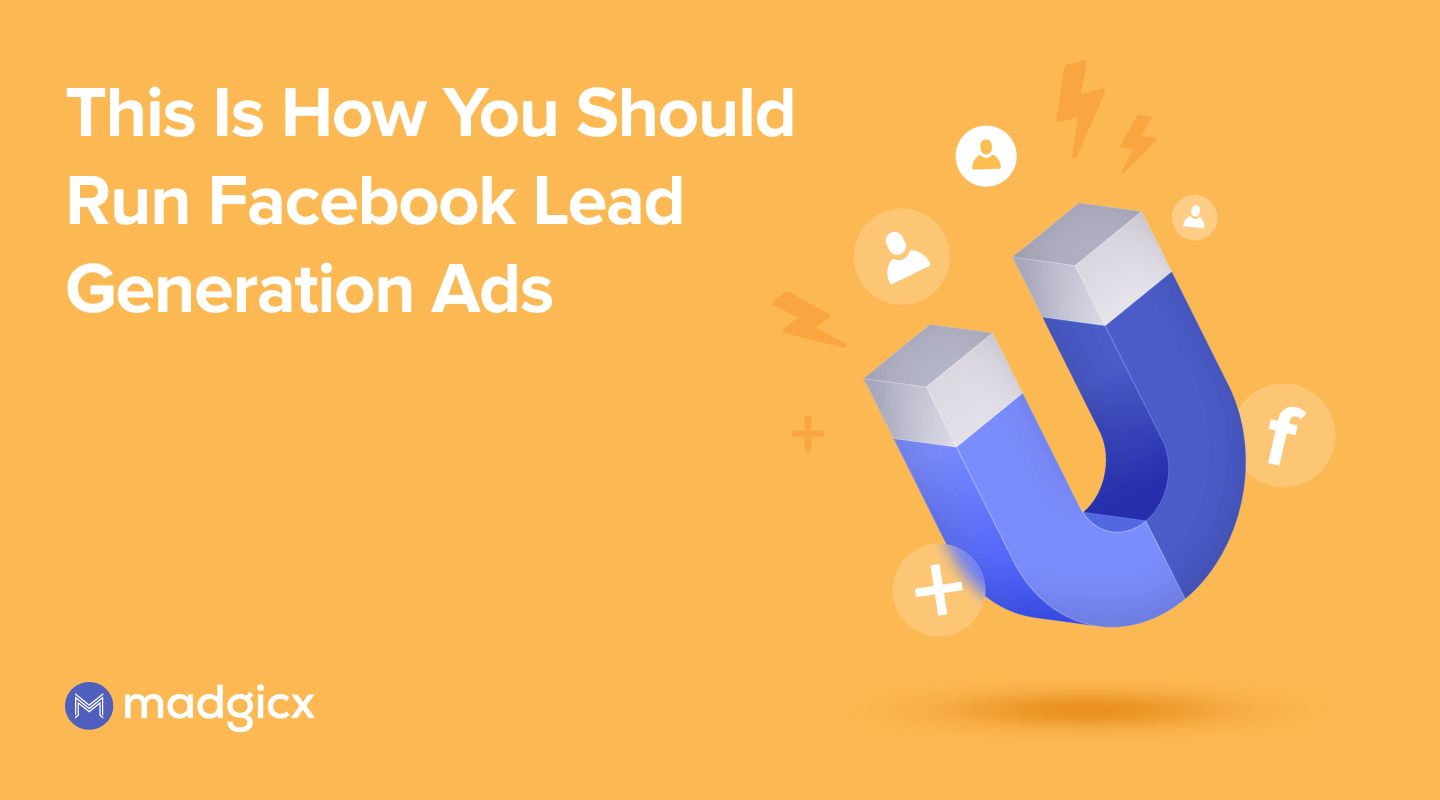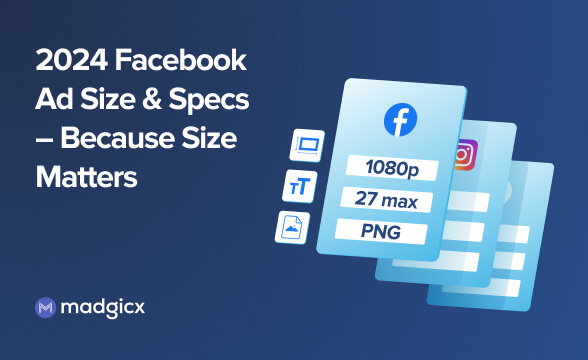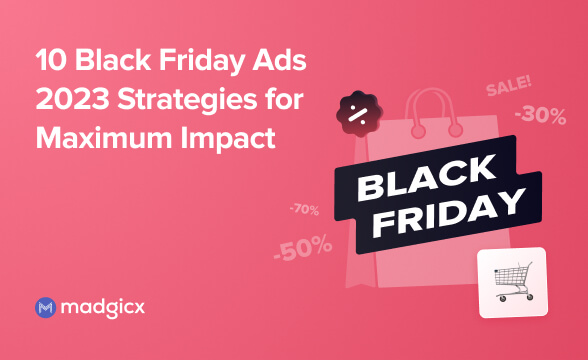Facebook lead generation ads are simple to launch but hard to get right. Learn how to create high-converting lead-generation ads with this guide.
In advertising, more is best—a saying that goes double for leads.
Whether your goal is to generate more downloads, newsletter signups, or demos, this guide to Facebook lead-generation ads will show you how to create your own campaigns on or off Facebook.
We'll also break down the top 3 rules you need to follow to be successful and show off some of our favorite examples from advertisers around the globe.
Facebook lead ads vs. conversion ads
Just like with any advertising strategy, there are different ways to achieve your end goals—and lead generation ads are no exception. There are two main ways to generate leads with Facebook campaigns.
1. Using the Conversions campaign objective with a self-hosted form on your own website,
OR
2. Using the Lead Generation objective with Facebook's instant form
Note: If you have the new simplified version of Facebook’s objectives, use Leads in both cases.
Of course, there are pros and cons to each option.
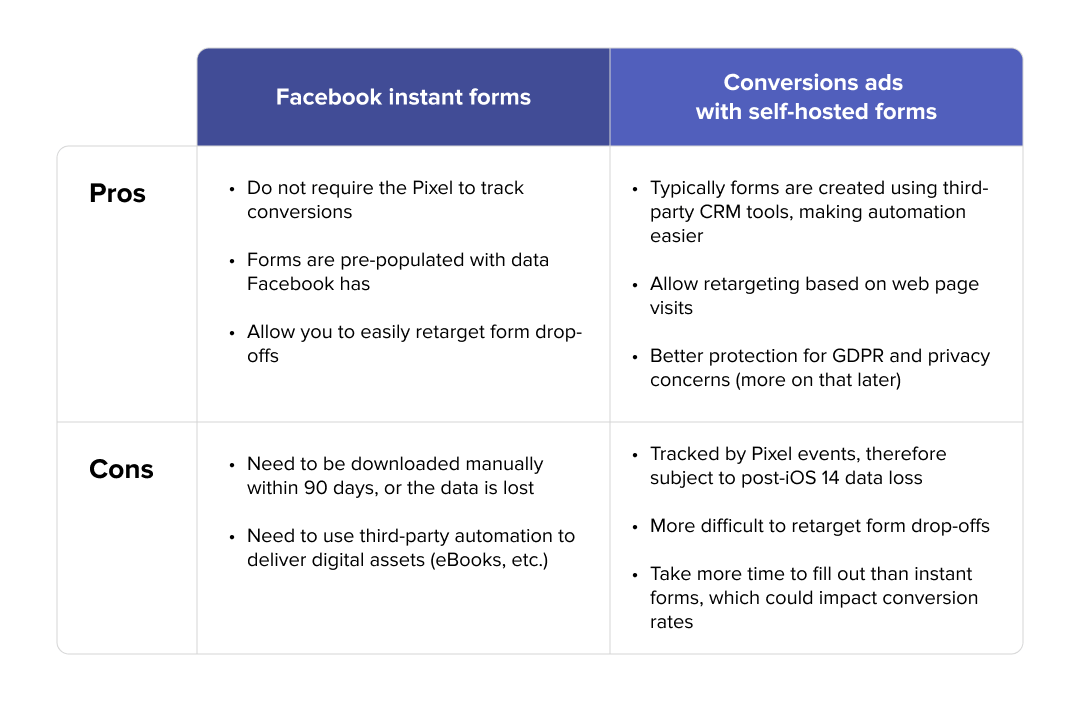
At the end of the day, the best advice we can give here is to test out both methods and see which one works best.
I've personally seen that a combination of both works best. Using instant forms targeted to mobile devices makes following out forms easier on the go, while I have seen better results driving desktop traffic to a form hosted on the company site. Your results may vary, of course.
How to create a Facebook lead generation campaign
As we just mentioned, there are two methods to gather leads with your Facebook ads: using Facebook's native instant form or a self-hosted form on your own website.
Let's cover how to create the latter type now.
To create a lead gen campaign with a form on your website, you'll want to create a campaign with the Conversion objective just as you normally would. Instead of directing users to your store page, you'll direct them to a landing page that has your form on it already.
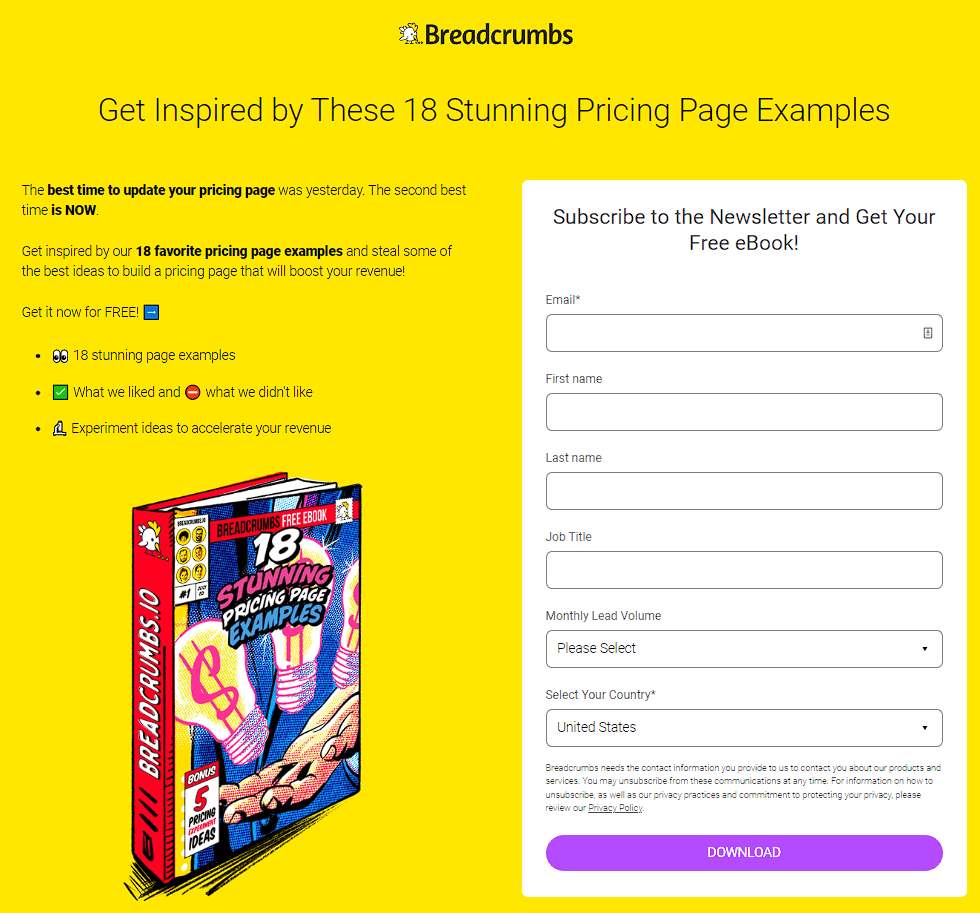
The trickier part of this setup is ensuring you can track the number of leads that filled out your form with the Pixel.
There are two main ways to make sure your leads are counted: either by triggering an event on a button click or triggering it when the user views the download/thank you page.
The only caveat with this method is that since you're using the Pixel to track downloads, it will be affected by the iOS 14 updates, meaning that iOS user data will more than likely be missing from your reporting.
...and that's it! Since you're hosting the form (usually with your CRMs form), there's nothing left to do on Facebook's side except to smash the publish button once you've finished your campaign setup.
How to create Facebook instant forms
Now that we've learned how to create a lead generation campaign with the Conversion objective and our website, let's learn how to create one using Facebook's Leads objective.
The first step is to select “Leads” from the objective list when creating a new campaign.

Feel free to change any settings you need inside the campaign tab before moving on.
Inside the ad set tab, there are a few settings we need to tweak before we can continue to creating your audience and lead form.
Under the ad set tab, we need to select Instant forms under the conversion location header.
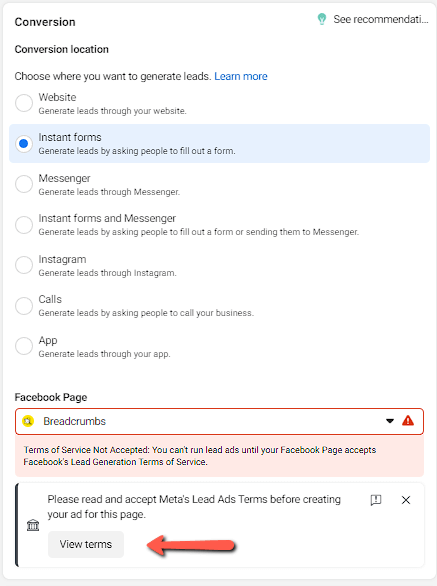
Another important step here is to ensure we have agreed to Facebook's Lead Generation Terms of Service.
In short, you acknowledge that you will follow Facebook's terms and any applicable data laws. You also agree that Meta can remove this feature at any time (typically for breaking any of these rules).
If you don't agree to these rules, you won't be able to create a lead generation ad with Facebook's lead ad forms.
After you select these options (and build out your audience), you can continue to the ad tab.
Here, you'll be able to build out the face of your ad just like you normally do. The only change here is that clicking on the CTA will open up an instant form instead of redirecting the user to your website.
If this is your first time creating a lead form, you'll find the option to create a new form here (or you can choose a form you have used in the past).
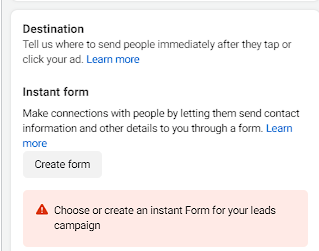
A few steps are needed to create this form, so let's cover that now. Up first is the form type selection.
Form type

There are a couple of different ways you can approach this based on your goals.
- More volume is the default instant form type. This type aims to make the form as quick and painless as possible by keeping the form pages to a minimum. This is great for simple lead generation tactics such as eBooks, case studies, or newsletter signups.
- Higher intent form type is a little different, as it adds a review step for the user to check that their information is correct before they submit it.
Given the extra effort involved on your audience's end, these leads are typically more engaged than those who can half-heartedly submit the previous form. It also informs the user that someone will follow up with them after submitting this form. For this reason, it's best used for sales-assisted selling motions like auto or home sales or scheduling demos and calls. - Custom forms are a bit more complex than either of these options. Custom forms are like micro landing pages as they allow you to create sections in your form to tell users about your product benefits, add customer testimonials and offers, and display additional product information.
If you have a longer or more complex offer that needs additional information, custom forms could be a better option than the other 2 mentioned.
For the purpose of this guide, we'll be going through the more volume form type.
After selecting the more volume type, we move on to the form intro field.
Form intro
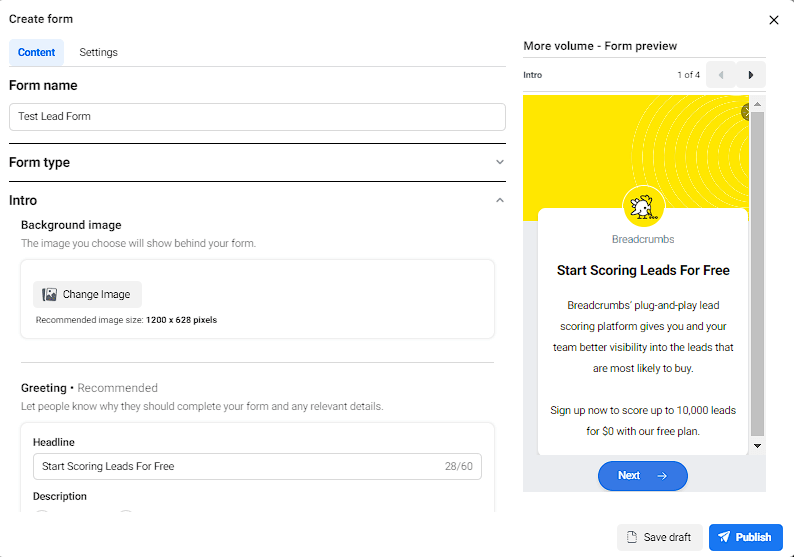
The form intro is the first thing your audience will see once they click on your CTA, so it's a great idea to reiterate the offer at hand and include some compelling copy to get your audience to finish the form.
Form questions
After this, we move on to the questions portion. While Facebook has some standard prefill questions (like email, name, phone number, etc.), you also have the opportunity to create your own custom questions.
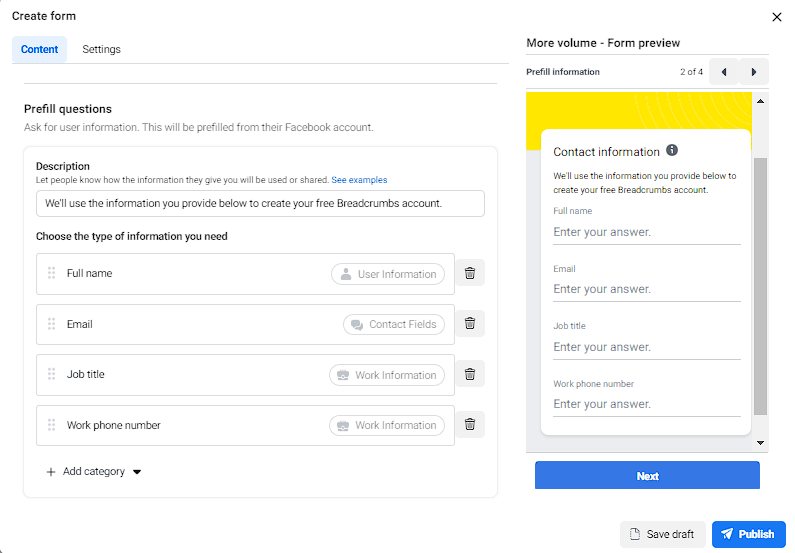
Better still, for those of you who need to pre-qualify your leads, Facebook also offers a lead filtering option. Here, you can add your own custom question and then select if that answer would pre-qualify your lead.
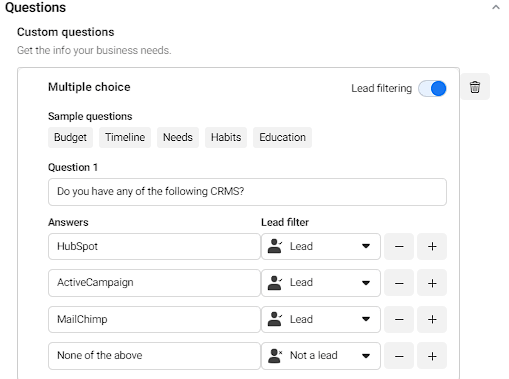
Those who are not qualified will not be able to fill out the form and will be redirected to a completion screen. Those who are qualified will be able to fill out the form like normal.
I wouldn't recommend this option for simple forms (eBooks, white papers, etc.), but for those of you who advertise high-ticket or specialized offers, this is a great way to ensure you're sending qualified leads over to your sales teams.
Privacy Policy
Next up is the privacy policy section—also known as the section your legal department is most worried about.

Since you'll be collecting personal information from your audience, they need to be able to read your privacy policy (and thus agree to its terms) before they hit that final submit button. Therefore, it's mandatory that your instant forms have this added to run lead-generation ads.
Note: ensure your Facebook lead ads comply with the GDPR
While it's true that technically, all you need to use these forms is the privacy policy, one thing your legal team won't want to neglect is your GDPR compliance.
While the full legal document for GDPR is around 261 pages, there are a few main bullet points that matter most to businesses:
- A person must know exactly what they're signing up for and agree to it explicitly
- A person must be able to receive all the data you have about them, as well as request a full deletion
- This data must be handled securely (encrypted)
- You should only ask for the information you need to provide the requested assets to the user
- You should only store the data for as long as you need it
Even though this only applies to the 27 nations in the EU, countries like Canada have their own version (CAN-SPAM), and states like California are slowly but surely gravitating to these laws as well.
In short, it's better to be safe than sorry when dealing with GDPR.
In order to ensure you have complete compliance, you can add a custom disclaimer to your lead ad form right below the privacy policy section.
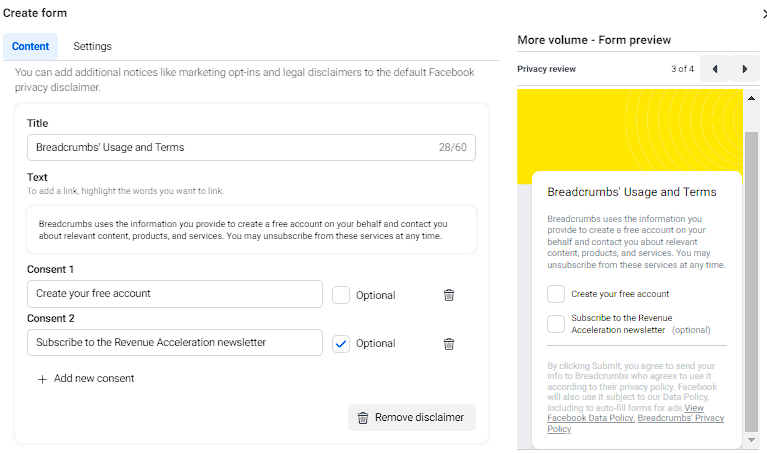
In the example above, we're directing our audience toward a free Breadcrumbs account. Therefore, we want to ensure our audience is aware that they will have an account created for them and that we will be using the info provided to deliver access to that account.
Since we'd also like to enroll our audience in our monthly newsletter to keep in touch, we've added an additional (and optional) checkbox to meet the compliance goal.
Even for simple things like eBook downloads, if you plan to reach out to your leads with anything other than a simple link to the asset they requested, you must have their consent to receive future communication.
Message for leads
Now that the legalese is out of the way, we can finish up our form with the message for leads section.
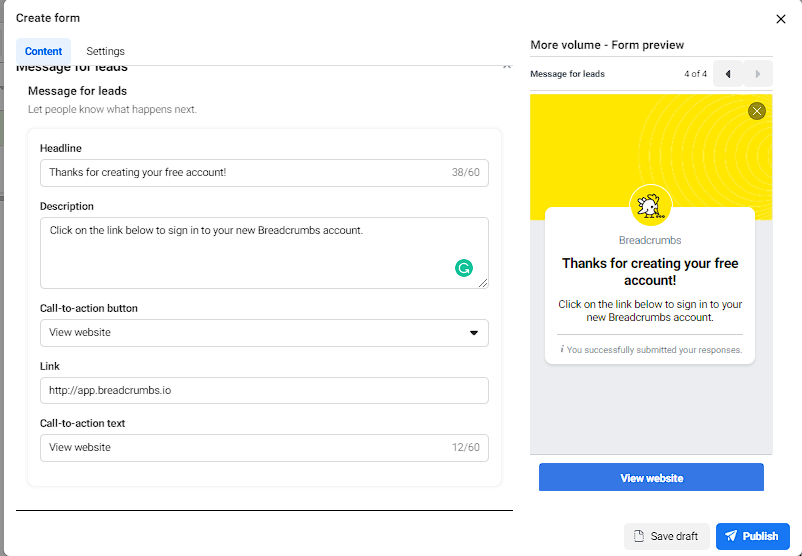
This is the last part of the form a user will see, so your goal here is to direct them on what will happen next. If your form is geared toward an asset download, add the link to the download page at this step.
If you will be reaching out to your leads, give them a time frame of when to expect this call or email and a link to view more information.
At any rate, the worst possible thing you can do here is to end with just a message that just says, "Thanks for filling out the form." Make sure to set clear guidelines on what happens next and when so your audience is not left hanging.
3 best practices for Facebook lead generation
With all the technical details out of the way, it's time for the most important part—creating Facebook lead ads that people actually want to interact with.
There are a few key practices to keep in mind to get the best results:
#1 Create an offer people would trade their data for. Around 84% of people say that they are at least somewhat concerned about the security and safety of their private data, and for good reason—companies have been mishandling and selling their info for decades now. Therefore, people are a little more closed-fisted with their personal information than ever before.
This means that, as an advertiser, you need to make sure that the value of what you're providing is worth the trust of your audience. Running ads that are generic and bland (looking at you, newsletter signups) and don't provide information on exactly what you'll receive will often go ignored.
#2 Only ask for the information you need. Keeping in line with what we just learned about GDPR, another crucial point is only asking for the data you need to give your lead what they requested. On top of the legal aspect, the longer a lead form is, the less likely it is to be completed.
#3 Automate your asset delivery with your CRM. People are used to instant results, especially when it comes to downloading assets like white papers, case studies, and eBooks. By default, Facebook lead forms are only able to provide you with the leads themselves, which you'll need to export manually. It is, therefore, your job to ensure that your leads receive their assets as requested.
The easiest way to do this is to sync your lead forms with your CRM (HubSpot, Mailchimp, ActiveCampaign, etc.) and create an automated workflow that instantly delivers it to your lead’s inbox.
Many big-name companies (like those just listed) have Facebook integrations embedded in their platforms, but you can use tools like Zapier to create custom connections if you have a lesser-known tool.
3 inspiring examples of Facebook lead ads
We can’t finish without examples, right? Let’s add some lead generation ads you like and explain what makes them special.
CeraVe
I’m a huge fan of this brand and, conversely, this marketing strategy. While many people think lead-generation ads are just for eBooks or sales calls, the truth is that even quizzes can be considered lead-generation ads as long as they capture information at the end.
There are a few reasons this ad is great to me:
- It’s an innocuous lead gen tactic—people love quizzes and personalization, so combining the two is fantastic
- Not only does this strategy give CeraVe a lead, but it also gives a complete picture of their lead's needs, making it a perfect way to personalize any email follow-ups and make the sale
- Since this quiz has multiple steps, it’s also a great opportunity to retarget those who fall off at any point
Great job, CeraVe!
The Knot
Anyone who has ever planned a wedding knows two things: it’s expensive and time-consuming. The Knot does a great job here highlighting (and solving) both issues.
We like this ad because:
- It puts the pain points front and center with ad copy
- It offers a free solution to help solve the problem
- The landing page is extremely clean and provides a great benefit breakdown
- The form is incredibly short (just 2 fields)
This strategy is perfect for SaaS businesses looking to get more signups.
Adobe
Short and sweet is how I’d describe this ad from Adobe, which is exactly what I look for in digital asset downloads like these.
This instant form download ticks several checkboxes for me:
- Form fields kept to a minimum
- Form message CTA directs me to the download page
- I received an email with the download within 2 minutes of submitting the form
The only thing I wish I would have seen was an added GDPR disclaimer, but as I live in the USA, it wouldn’t apply to me anyway. It’s always possible that they are running ads with a different form to audiences within those 27 countries that are GDPR-compliant.
Conclusion
While we've covered a lot of technical guides on how to create Facebook lead ads, you still need to know how to manage, optimize, and report on your campaigns so you can improve your cost per lead over time.
The answer? Creating your own free Madgicx account, of course. :)
Madgicx is the one tool that can help you analyze, automate, and optimize any campaign objective—including lead ads.
If that weren't enough, Madgicx even gives you the option to select lead generation as your account type, which creates a tailor-made dashboard that shows you the metrics you need to track to be successful.
See why advertisers prefer Madgicx (and grab your free 7-day trial) here.
Get access to a dashboard made by expert lead gen advertisers to ensure you’re covering all the metrics you should track. Try Madgicx's One-Click Report for free.
Tory is a digital marketing specialist and the current Marketing Manager of Breadcrumbs.io. She's been featured in various high-profile marketing blogs like Hootsuite, AdEspresso, and Databox and holds certificates for both Google and Facebook Ads. In her spare time, she gardens and paints from her house in the Florida panhandle.



